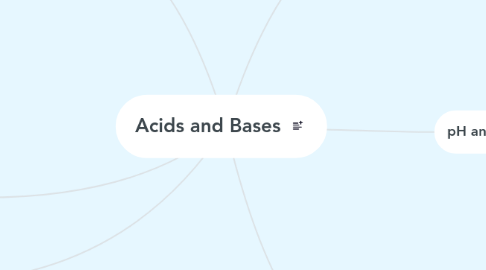Acids and Bases
저자: Magnus Drechsler


1. Greater pKa, greater Ka, means strong acid
2. Kw/ Ka/ Kb
2.1. pKa and pKb
2.1.1. Pka=-log10Ka Pkb=-log10Kb
2.2. Ka=([H+][A-])/[HA] =Kc[H2O]
2.2.1. high Ka (acid dissociation constant) =>strong acid
2.3. Kb=([BH+][OH-])/[B]
2.3.1. high Kb (base dissociation constant) =>strong base
2.4. kw= [H+][OH-]=1 x 10^-14
2.5. If Ka or Kb value is very small, the initial and equilibrium concentrations of acids and base are similar.
3. Bronsted lowry acids and bases
3.1. Bronsted Lowry Acid (H+) proton donor - electrophiles
3.2. Bronsted Lowrey Base (H+) acceptor - nucleophiles
3.3. Strong Acid < completely dissociated/good proton donor
3.4. Weak Acid < partially dissociated/ poor proton donor and its aqueous solution shows poor conductivity.
4. Strong/Weak Acids and Bases
4.1. Acid
4.1.1. Strong
4.1.1.1. HCl, HNO3, H2SO4
4.1.2. Weak
4.1.2.1. CH3COOH, H2CO3, H3PO4
4.2. Base
4.2.1. Strong
4.2.1.1. NaOH, KOH, LiOH
4.2.2. Weak
4.2.2.1. NH3. C2H5NH2
4.3. Strong acid/base: fully dissociate in water
4.3.1. shows higher electrical conductivity
4.4. Weak acid/base: partially dissociate in water
5. Lewis acids and bases
5.1. Lewis acid receives electron pair
5.2. Lewis base donates electron pair
5.3. Lewis Acid - accept lone pair.
5.4. Lewis Base - donate lone pair.
5.5. When Lewis acid (reacts with) + Lewis base = Covalent bonds are formed.
6. pH and pOH
6.1. pH: -log10[H+(aq)]
6.2. pOH: -log10[OH-(aq)]
6.3. pH + POH = 14 = Pkw
6.4. low pH -> more acidic
6.5. As pH increases, pOH decreases
6.5.1. [H+] > [OH-] -> acidic
6.5.2. [H+] = [OH-] -> neutral
6.5.3. [H+] < [OH-] -> alkaline
